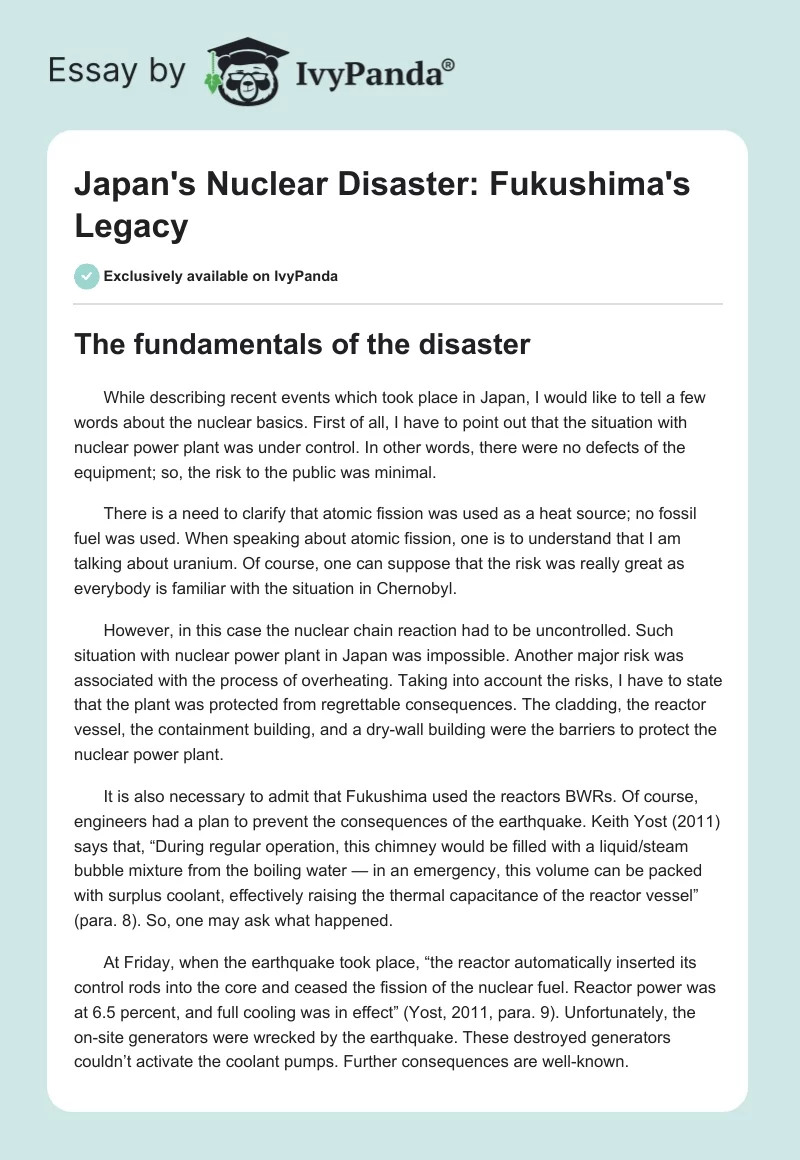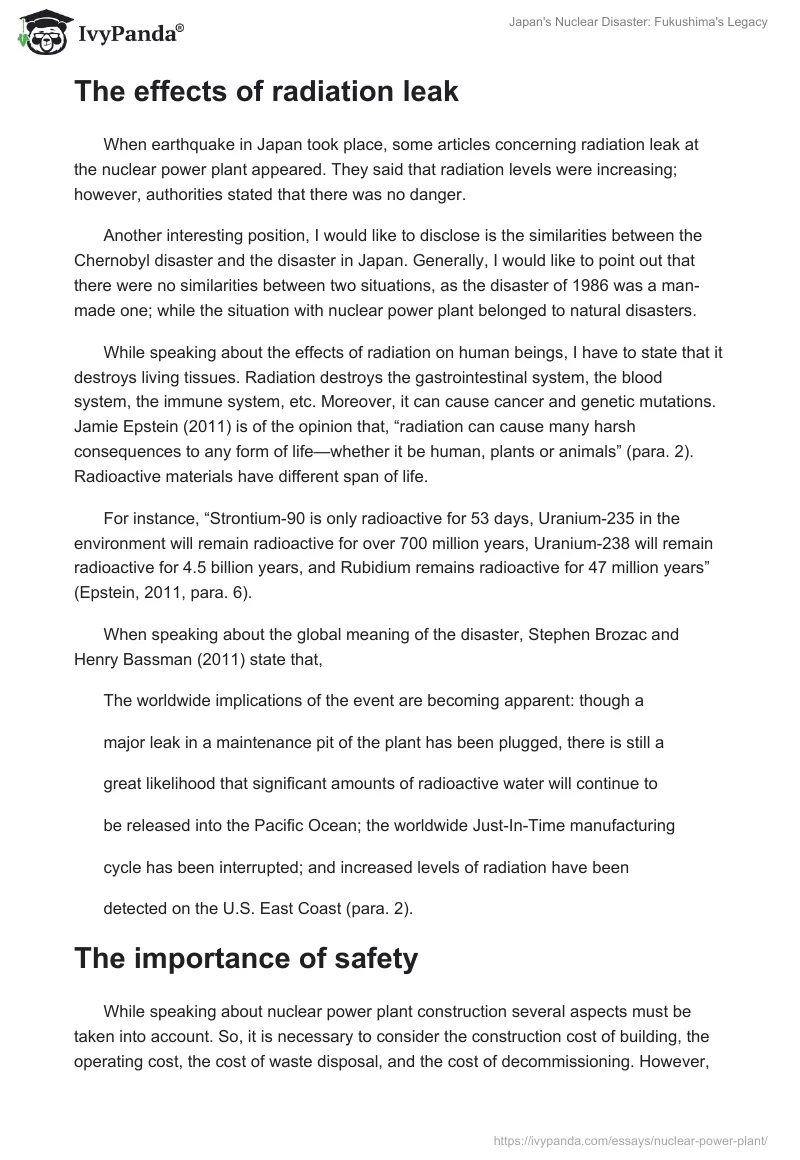The fundamentals of the disaster
While describing recent events which took place in Japan, I would like to tell a few words about the nuclear basics. First of all, I have to point out that the situation with nuclear power plant was under control. In other words, there were no defects of the equipment; so, the risk to the public was minimal.
There is a need to clarify that atomic fission was used as a heat source; no fossil fuel was used. When speaking about atomic fission, one is to understand that I am talking about uranium. Of course, one can suppose that the risk was really great as everybody is familiar with the situation in Chernobyl.
However, in this case the nuclear chain reaction had to be uncontrolled. Such situation with nuclear power plant in Japan was impossible. Another major risk was associated with the process of overheating. Taking into account the risks, I have to state that the plant was protected from regrettable consequences. The cladding, the reactor vessel, the containment building, and a dry-wall building were the barriers to protect the nuclear power plant.
It is also necessary to admit that Fukushima used the reactors BWRs. Of course, engineers had a plan to prevent the consequences of the earthquake. Keith Yost (2011) says that, “During regular operation, this chimney would be filled with a liquid/steam bubble mixture from the boiling water — in an emergency, this volume can be packed with surplus coolant, effectively raising the thermal capacitance of the reactor vessel” (para. 8). So, one may ask what happened.
At Friday, when the earthquake took place, “the reactor automatically inserted its control rods into the core and ceased the fission of the nuclear fuel. Reactor power was at 6.5 percent, and full cooling was in effect” (Yost, 2011, para. 9). Unfortunately, the on-site generators were wrecked by the earthquake. These destroyed generators couldn’t activate the coolant pumps. Further consequences are well-known.
The effects of radiation leak
When earthquake in Japan took place, some articles concerning radiation leak at the nuclear power plant appeared. They said that radiation levels were increasing; however, authorities stated that there was no danger.
Another interesting position, I would like to disclose is the similarities between the Chernobyl disaster and the disaster in Japan. Generally, I would like to point out that there were no similarities between two situations, as the disaster of 1986 was a man-made one; while the situation with nuclear power plant belonged to natural disasters.
While speaking about the effects of radiation on human beings, I have to state that it destroys living tissues. Radiation destroys the gastrointestinal system, the blood system, the immune system, etc. Moreover, it can cause cancer and genetic mutations. Jamie Epstein (2011) is of the opinion that, “radiation can cause many harsh consequences to any form of life—whether it be human, plants or animals” (para. 2). Radioactive materials have different span of life.
For instance, “Strontium-90 is only radioactive for 53 days, Uranium-235 in the environment will remain radioactive for over 700 million years, Uranium-238 will remain radioactive for 4.5 billion years, and Rubidium remains radioactive for 47 million years” (Epstein, 2011, para. 6).
When speaking about the global meaning of the disaster, Stephen Brozac and Henry Bassman (2011) state that,
The worldwide implications of the event are becoming apparent: though a
major leak in a maintenance pit of the plant has been plugged, there is still a
great likelihood that significant amounts of radioactive water will continue to
be released into the Pacific Ocean; the worldwide Just-In-Time manufacturing
cycle has been interrupted; and increased levels of radiation have been
detected on the U.S. East Coast (para. 2).
The importance of safety
While speaking about nuclear power plant construction several aspects must be taken into account. So, it is necessary to consider the construction cost of building, the operating cost, the cost of waste disposal, and the cost of decommissioning. However, the most important point, which must be taken into consideration, is safety of nuclear power plants.
The major safety components include control of radioactivity, maintenance of core cooling, and maintenance of barriers. The last component is extremely important to prevent the spreading of radiation.
According to Nuclearinfo.net, radiation doses at nuclear power plant must be thoroughly controlled. “Monitoring of individual doses and of the work environment, limit on the time a worker spends in areas with significant radiation levels, physical shielding, and the handling of equipment via remote in the core of the reactor” (Nuclearinfo.net, 2012, para. 9) are recognized to be the most important procedures, which prevent radiation doses rising.
Of course, it is necessary to regulate the neutron flux. To reduce the level of the radioactivity, it is necessary to reduce the neutron flux. If there is no opportunity to use water to cool the system, sodium or sodium salts can replace water. Thus, the chemical elements will be used as a coolant.
Finally, it is better to build nuclear power plants away from towns, cities or villages.
References
Brozac, S. & Bassman, H. (2011). Fukushima: A Nuclear Threat to Japan, the U.S. and the World. Web.
Epstein, J. (2011). Devastating Effects to Environment due to Japan’s Radiation Leaks. Web.
Nuclearinfo.net. (2012). Safety Mechanisms of a Nuclear Power Reactor. Web.
Yost, K. (2011). Opinion: What Happened at the Fukushima Reactor? Web.


